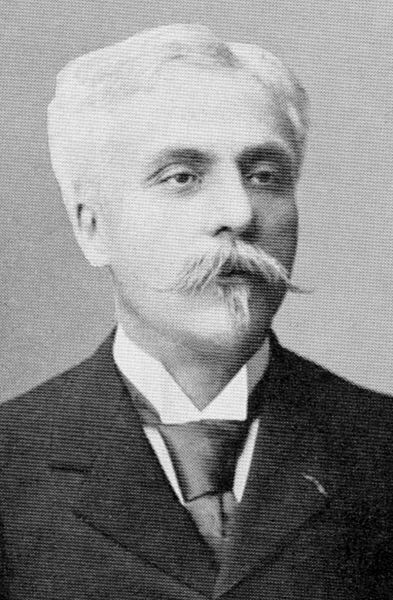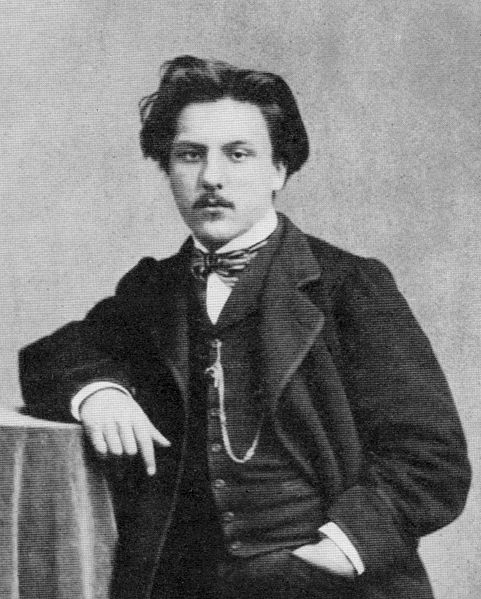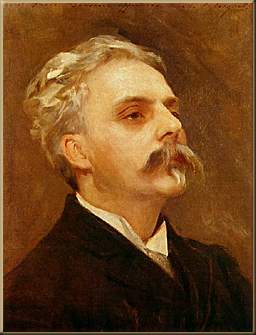<Back to Index>
- Pediatrician Clemens Peter von Pirquet, 1874
- Composer Gabriel Urbain Fauré, 1845
- King of Sweden Gustav I Vasa, 1496
PAGE SPONSOR



Gabriel Urbain Fauré (12 May 1845 – 4 November 1924) was a French composer, organist, pianist, and teacher. He was the foremost French composer of his generation, and his musical style influenced many 20th century composers. His harmonic and melodic language affected how harmony was later taught.
Fauré was born in Pamiers, Ariège, Midi-Pyrénées, to Toussaint-Honoré Fauré and Marie-Antoinette-Hélène Lalène-Laprade. The youngest child of a large brood, he was sent to live with a wet nurse until he was four years old. At the age of nine he was sent off again, this time to Paris to study at the École Niedermeyer, a school which prepared church organists and choir directors. Fauré biographer Jessica Duchen suggests that these forced separations from his family may have contributed to periods of depression he suffered in later life. During the 11 years he attended the École Niedermeyer, Fauré studied with several prominent French musicians, notably including Camille Saint-Saëns, who introduced him to the music of contemporary composers like Robert Schumann and Franz Liszt.
In 1870, Fauré enlisted in the army and took part in the action to raise the Siege of Paris during the Franco-Prussian War. During the Paris Commune he stayed at Rambouillet and in Switzerland, where he taught at the transported École Niedermeyer. When he returned to Paris in October 1871, he was appointed assistant organist at Saint-Sulpice as accompanist to the choir, and became a regular at Saint-Saëns' salon. Here he met many prominent Parisian musicians and with those he met there and at the salon of Pauline Viardot he formed the Société Nationale de Musique. In 1874, Fauré stopped working at Saint-Sulpice and began to fill in at the Église de la Madeleine for Saint-Saëns during his many absences. When Saint-Saëns retired in 1877, Fauré became choirmaster. In the same year he became engaged to Marianne Viardot, daughter of Pauline Viardot, but the engagement was later broken off by Marianne. Following this disappointment he travelled to Weimar, where he met Liszt, and Cologne in order to see productions of Richard Wagner's Der Ring des Nibelungen. Fauré admired Wagner, but was one of few composers of his generation not to come under his influence.
In 1883, Fauré married Marie Fremiet, with whom he had two sons. In order to support his family Fauré spent most of his time in organising daily services at the Église de la Madeleine and teaching piano and harmony lessons. He only had time to compose during the summers. He earned almost no money from his compositions because his publisher bought them, copyright and all, for 50 francs each. During this period Fauré wrote several large scale works, in addition to many piano pieces and songs, but he destroyed many of them after a few performances, only retaining a few movements in order to re-use any motifs.
During his youth Fauré appeared to be very cheerful, but his broken engagement combined with his perceived lack of musical success precipitated bouts of depression which he described as "spleen". In the 1890s, however, his fortunes improved somewhat. He had a successful trip to Venice where he met with friends and wrote several works. In 1892, he became the inspector of the music conservatories in the French provinces, which meant he no longer had to teach amateur students. In 1896, he finally became chief organist at the Église de la Madeleine, and also succeeded Jules Massenet as composition instructor at the Conservatoire de Paris. At this post he taught many important French composers, including Maurice Ravel and Nadia Boulanger.
From 1903 to 1921, Fauré was a critic for Le Figaro. In 1905, he succeeded Théodore Dubois as director of the Paris Conservatory. He made many changes at the Conservatoire, leading to the resignation of a number of faculty members. This position meant that he was better off in terms of income, and he also became much more widely known as a composer.
Fauré was elected to the Institut de France in 1909, but at the same time he broke with the Société Nationale de Musique, and supported the rogue group which formed out of those ejected from the Société, mainly his own students. During this time Fauré developed ear trouble and gradually lost his hearing. Sound not only became fainter, but it was also distorted, so that pitches on the low and high ends of his hearing sounded like other pitches. He made efforts to conceal his difficulty, but was eventually forced to abandon his teaching position.
His responsibilities at the Conservatoire, combined with his hearing loss, meant that Fauré's output was greatly reduced during this period. During World War I Fauré remained in France. In 1920, at the age of 75, he retired from the Conservatoire mainly due to his increasing deafness. In this year he also received the Grand-Croix of the Légion d'honneur, an honor rare for a musician. He suffered from poor health, partially brought on by heavy smoking. Despite this, he remained available to young composers, including members of Les six, who were devoted to him.
Gabriel
Fauré died in Paris from pneumonia in 1924. He was given a
state funeral at the Église
de
la Madeleine and
is buried in the Passy Cemetery in Paris. Gabriel
Fauré is regarded as the master of the French art song, or mélodie.
His
works ranged from an early romantic style, when in his early years
he emulated the style of Mendelssohn and others, to late 19th
century Romantic,
and
finally to a 20th
century aesthetic. His work was based on a strong understanding of
harmonic structures which he received at the École
Niedermeyer from
his harmony teacher Gustave Lefèvre, who wrote the book Traité d'harmonie (Paris, 1889), in which
Lefèvre sets forth a harmonic theory which differs significantly from the classical theory of Jean-Philippe
Rameau in that
seventh and ninth chords are no longer considered dissonant,
and the mediant can be altered without
changing the mode.
In
addition, Fauré's understanding of the church
modes can be seen
in various modal passages in his works, especially in his melodies. In
contrast with his harmonic and melodic style, which pushed the bounds
for his time, Fauré's rhythmic motives tended to be subtle and
repetitive, with little to break the flow of the line, although he did
utilize subtle large scale syncopations, similar to those found in Brahms's works. Aaron
Copland referred to
him as the 'French Brahms'. It has also been posited by
Jerry Dubins in Fanfare
Magazine that Gabriel Fauré is the "missing link" between Brahms and Debussy. Fauré's
piano
works often use arpeggiated figures with the melody
interspersed between the two hands, and include finger substitutions
natural for organists. These aspects make them daunting for some
pianists, but they are nonetheless central works. Fauré
was
a prolific composer, and among the most noteworthy of his works are
his Requiem,
the opera Pénélope,
the orchestral
suite Masques et
bergamasques (based
on
music for a dramatic entertainment, or divertissement comique),
and
music for Pelléas
et
Mélisande. He also wrote chamber
music; his two piano
quartets are
particularly well known. Other chamber music includes two piano
quintets, two cello
sonatas, two violin
sonatas, a string
quartet, a piano
trio and a number of piano pieces including the Nocturnes. He is also known for his songs, such as Après
un
rêve, Les
roses d'Ispahan, En
prière, and several song
cycles, including La
bonne
chanson with
settings of poems by Verlaine,
and L'horizon
chimérique. The Requiem,
Op.
48, was not composed to the memory of a specific person but, in
Fauré's words, "for the pleasure of it." It was first performed
in 1888. Fauré is thought not to have had strong religious
beliefs. It has been described as "a lullaby of death". In setting his requiem, he
left out the Dies
irae, though the reference to the day of judgment appears in the Libera
me, which, like Giuseppe
Verdi, he added to the normal requiem mass. Several slightly
different versions of the Requiem exist, and these have given
rise to a number of different recordings. Personal grief may have
influenced the composition as it was started after the death of his
father, and before it was completed, his mother died as well. The Requiem can thus be seen as an
expression of Fauré's personal tragedy written after the death of his parents. The Requiem is also acknowledged as a
source of inspiration for the
similar
setting by Maurice
Duruflé. Fauré
wrote
his Dolly
Suite for piano
four-hands between
1894 and 1897 and dedicated it to Hélène, daughter of the
singer Emma
Bardac, with whom he was having an affair; he also wrote La bonne chanson for Emma herself. In the
UK, the first piece, Berceuse,
from the Dolly Suite became known to several generations of children as
the closing music for the BBC
Home
Service radio
programme Listen with
Mother, which was broadcast from 1950 to 1982. His music
is used in "Act I: Emeralds" of George
Balanchine's ballet Jewels (1967).